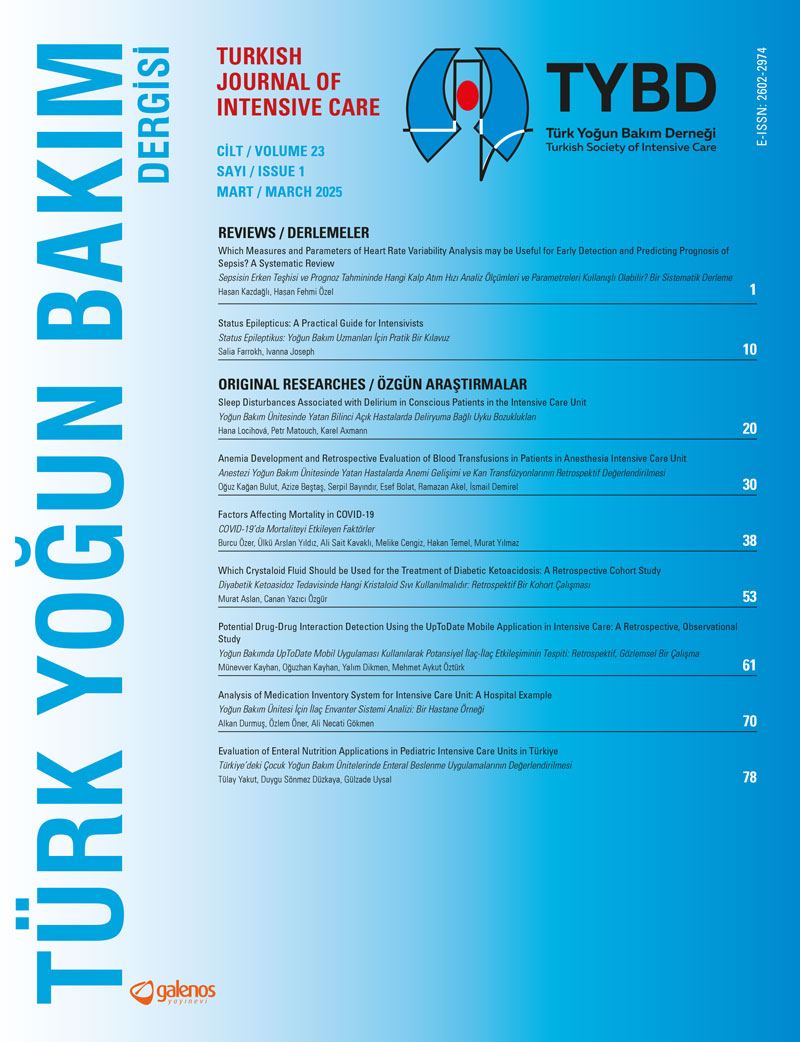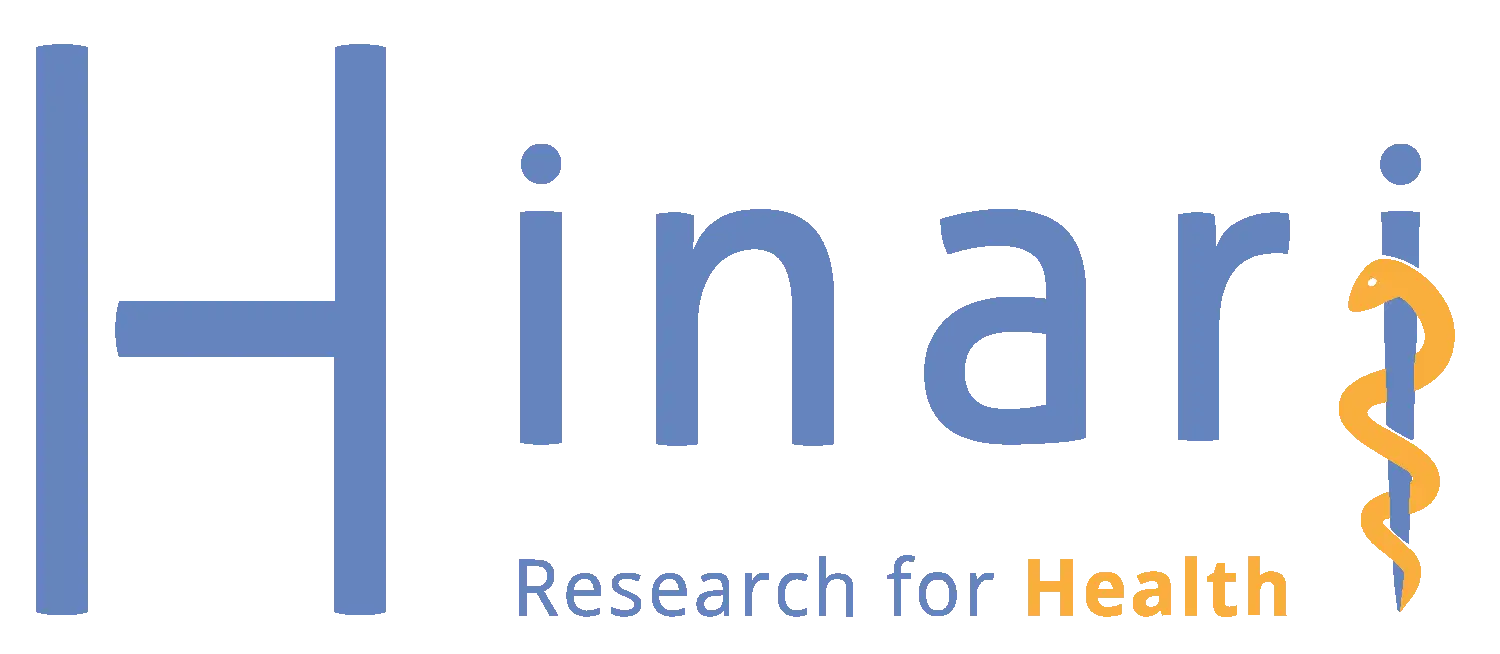Öz
Amaç
Çalışmanın temel amacı, sayısal derecelendirme ölçeği (NRS) ile değerlendirilen öznel uyku kalitesi ile hem yoğun bakım ünitesi için konfüzyon değerlendirme yöntemi (CAM-ICU) hem de yoğun bakım deliryum tarama kontrol listesi (ICDSC) ile tanımlanan deliryum varlığı arasındaki ilişkiyi analiz etmektir. İkincil amaç ise seçilen diğer belirleyicilerin deliryum üzerindeki etkisini analiz etmekti.
Gereç ve Yöntem
Prospektif gözlemsel çalışmaya yoğun bakım ünitesinde 24 saatten fazla kalan entübe olmayan 126 hasta dahil edildi. Deliryum her iki cihazla (CAM-ICU ve ICDSC) eş zamanlı olarak günde iki kez, algılanan uyku kalitesi (NRS) ise günde bir kez değerlendirildi. Yüz yirmi altı hastadan 1299 eşleştirilmiş anket ve 278 NRS kaydı elde edildi.
Bulgular
CAM-ICU pozitif veya ICDSC skoru ≥4 olan sırasıyla 37 (%29,4) ve 40 (%31,7) hasta vardı. Doksan üç hastada (%73,8) NRS ≤5 bulundu. Deliryum insidansı (iki araçla değerlendirilen) ile uyku kalitesi (NRS ≤5) arasında istatistiksel olarak anlamlı bir ilişki doğrulandı. CAM-ICU pozitifliği 0,391 [%95 güven aralığı (GA), 0,36 ila 0,421 (p<0,001)] ve ICDSC pozitifliği 0,463 [%95 GA, 0,435 ila 0,491 (p<0,001)]. Bu ilişkinin gücü (Kendall’s Tau kullanılarak değerlendirildi) orta düzeyde olarak derecelendirildi.
Sonuç
Çalışma deliryum ile subjektif olarak değerlendirilen uyku kalitesi arasında bir ilişki olduğunu düşündürmektedir. Bu bakımdan, uyku bozukluklarının, kesin bir risk faktörü olduğunu doğrulayan geçerli objektif veriler olmasa bile, deliryum gelişimine katkıda bulunması muhtemeldir.
Anahtar Kelimeler: Yoğun bakım ünitesi, deliryum, uyku bozuklukları, deliryum tarama aracı
Referanslar
- Watson PL, Ceriana P, Fanfulla F. Delirium: is sleep important? Best Pract Res Clin Anaesthesiol. 2012;26:355-66.
- Trompeo AC, Vidi Y, Locane MD, Braghiroli A, Mascia L, Bosma K, et al. Sleep disturbances in the critically ill patients: role of delirium and sedative agents. Minerva Anestesiol. 2011;77:604-12.
- Boesen HC, Andersen JH, Bendtsen AO, Jennum PJ. Sleep and delirium in unsedated patients in the intensive care unit. Acta Anaesthesiol Scand. 2016;60:59-68.
- Drouot X, Roche-Campo F, Thille AW, Cabello B, Galia F, Margarit L, et al. A new classification for sleep analysis in critically ill patients. Sleep Medicine. 2012;13:7-14.
- Fadayomi AB, Ibala R, Bilotta F, Westover MB, Akeju O. A systematic review and meta-analysis examining the impact of sleep disturbance on postoperative delirium. Crit Care Med. 2018;46:e1204-12.
- Figueroa-Ramos MI, Arroyo-Novoa CM, Lee KA, Padilla G, Puntillo KA. Sleep and delirium in ICU patients: a review of mechanisms and manifestations. Intensive Care Med. 2009;35:781-95.
- Mistraletti G, Iapichino G, Destrebecq A, Taverna M. Sleep and delirium in the intensive care unit. Minerva Anestesiol. 2008;74:329-33.
- Devlin JW, Skrobik Y, Gélinas C, Needham DM, Slooter AJC, Pandharipande PP, et al. Clinical practice guidelines for the prevention and management of pain, agitation/sedation, delirium, immobility, and sleep disruption in adult patients in the ICU. Crit Care Med. 2018;46:e825-73.
- Bergeron N, Dubois MJ, Dumont M, Dial S, Skrobik Y. Intensive care delirium screening checklist: evaluation of a new screening tool. Intensive Care Med. 2001;27:859-64.
- Mitášová A, Bednařík J, Košťálová M, Michalčáková R, Ježková M, Kašpárek T. Standardization of the Czech Version of The Confusion Assessment Method for the Intensive Care Unit (CAM‑ICUcz). Cesk Slov Neurol N. 2010;73(3):258-66.
- Wild D, Grove A, Martin M, Eremenco S, McElroy S, Verjee-Lorenz A, et al. Principles of good practice for the translation and cultural adaptation process for patient-reported outcomes (PRO) measures: report of the ISPOR task force for translation and cultural adaptation. Value Health. 2005;8:94-104.
- Rood P, Frenzel T, Verhage R, Bonn M, van der Hoeven H, Pickkers P, et al. Development and daily use of a numeric rating score to assess sleep quality in ICU patients. J Crit Care. 2019;52:68-74.
- De Vaus D. Analyzing social science data: 50 key problems in data analysis. New York: SAGE Publications Ltd; 2002.
- Hayhurst CJ, Pandharipande PP, Hughes CG. Intensive care unit delirium: a review of diagnosis, prevention, and treatment. Anesthesiology. 2016;125:1229-41.
- Ely EW, Inouye SK, Bernard GR, Gordon S, Francis J, May L, et al. Delirium in mechanically ventilated patients: validity and reliability of the confusion assessment method for the intensive care unit (CAM-ICU). JAMA. 2001;286:2703-10.
- Krewulak K, Stelfox H, Leigh J, Ely E, Fiest K. Incidence and prevalence of delirium subtypes in an adult ICU: a systematic review and meta-analysis. Crit Care Med. 2018;46:2029-35.
- Serafim RB, Soares M, Bozza FA, Lapa E Silva JR, Dal-Pizzol F, Paulino MC, et al. Outcomes of subsyndromal delirium in ICU: a systematic review and meta-analysis. Crit Care. 2017;21:179.
- Honarmand K, Rafay H, Le J, Mohan S, Rochwerg B, Devlin JW, et al. A systematic review of risk factors for sleep disruption in critically ill adults. Critical Care Medicine. 2020;48:1066-74.
- Ouimet S, Kavanagh BP, Gottfried SB, Skrobik Y. Incidence, risk factors and consequences of ICU delirium. Intensive Care Med. 2007;33:66-73.
- Kamdar BB, Niessen T, Colantuoni E, King LM, Neufeld KJ, Bienvenu OJ, et al. Delirium transitions in the medical ICU: exploring the role of sleep quality and other factors. Crit Care Med. 2015;43:135-41.
- Patel J, Baldwin J, Bunting P, Laha S. The effect of a multicomponent multidisciplinary bundle of interventions on sleep and delirium in medical and surgical intensive care patients. Anaesthesia. 2014;69:540-9.
- Van Rompaey B, Elseviers MM, Van Drom W, Fromont V, Jorens PG. The effect of earplugs during the night on the onset of delirium and sleep perception: a randomised controlled trial in intensive care patients. Crit Care. 2012;16:R73.
- Davoudi A, Manini TM, Bihorac A, Rashidi P. Role of wearable accelerometer devices in delirium studies: a systematic review. Crit Care Explor. 2019;1:e0027.
- Flannery AH, Oyler DR, Weinhouse GL. The impact of interventions to improve sleep on delirium in the ICU: a systematic review and research framework. Crit Care Med. 2016;44:2231-40.
- Ely EW, Siegel MD, Inouye SK. Delirium in the intensive care unit: an under-recognized syndrome of organ dysfunction. Semin Respir Crit Care Med. 2001;22:115-26.
- Zaal IJ, Devlin JW, Peelen LM, Slooter AJC. A systematic review of risk factors for delirium in the ICU. Crit Care Med. 2015;43:40-7.
- Van Rompaey B, Elseviers MM, Schuurmans MJ, Shortridge-Baggett LM, Truijen S, Bossaert L. Risk factors for delirium in intensive care patients: a prospective cohort study. Crit Care. 2009;13:R77.
Telif hakkı ve lisans
Telif hakkı © 2025 Yazar(lar). Açık erişimli bu makale, orijinal çalışmaya uygun şekilde atıfta bulunulması koşuluyla, herhangi bir ortamda veya formatta sınırsız kullanım, dağıtım ve çoğaltmaya izin veren Creative Commons Attribution License (CC BY) altında dağıtılmıştır.






















